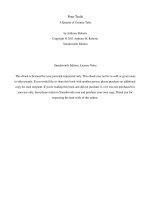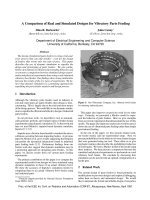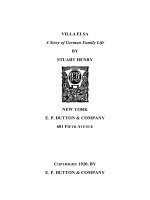A Laodicean: A Story of To-Day
Bạn đang xem bản rút gọn của tài liệu. Xem và tải ngay bản đầy đủ của tài liệu tại đây (89.14 KB, 11 trang )
A Laodicean: A Story of To-Day
by
Thomas Hardy
Web-Books.Com
A Laodicean: A Story of To-Day
PREFACE........................................................................................................................... 3
BOOK THE FIRST: George Somerset............................................................................... 4
BOOK THE SECOND: Dare And Havill....................................................................... 103
BOOK THE THIRD: De Stancy..................................................................................... 147
BOOK THE FOURTH: Somerset, Dare And De Stancy............................................... 216
BOOK THE FIFTH: De Stancy And Paula.................................................................... 240
BOOK THE SIXTH: Paula............................................................................................. 319
PREFACE
The changing of the old order in country manors and mansions may be slow or
sudden, may have many issues romantic or otherwise, its romantic issues being
not necessarily restricted to a change back to the original order; though this
admissible instance appears to have been the only romance formerly recognized
by novelists as possible in the case. Whether the following production be a
picture of other possibilities or not, its incidents may be taken to be fairly well
supported by evidence every day forthcoming in most counties.
The writing of the tale was rendered memorable to two persons, at least, by a
tedious illness of five months that laid hold of the author soon after the story was
begun in a well-known magazine; during which period the narrative had to be
strenuously continued by dictation to a predetermined cheerful ending.
As some of these novels of Wessex life address themselves more especially to
readers into whose souls the iron has entered, and whose years have less
pleasure in them now than heretofore, so "A Laodicean" may perhaps help to
while away an idle afternoon of the comfortable ones whose lines have fallen to
them in pleasant places; above all, of that large and happy section of the reading
public which has not yet reached ripeness of years; those to whom marriage is
the pilgrim's Eternal City, and not a milestone on the way. T.H.
January 1896.
BOOK THE FIRST: George Somerset
The sun blazed down and down, till it was within half-an-hour of its setting; but
the sketcher still lingered at his occupation of measuring and copying the
chevroned doorway--a bold and quaint example of a transitional style of
architecture, which formed the tower entrance to an English village church. The
graveyard being quite open on its western side, the tweed-clad figure of the
young draughtsman, and the tall mass of antique masonry which rose above him
to a battlemented parapet, were fired to a great brightness by the solar rays, that
crossed the neighbouring mead like a warp of gold threads, in whose mazes
groups of equally lustrous gnats danced and wailed incessantly.
He was so absorbed in his pursuit that he did not mark the brilliant chromatic
effect of which he composed the central feature, till it was brought home to his
intelligence by the warmth of the moulded stonework under his touch when
measuring; which led him at length to turn his head and gaze on its cause.
There are few in whom the sight of a sunset does not beget as much meditative
melancholy as contemplative pleasure, the human decline and death that it
illustrates being too obvious to escape the notice of the simplest observer. The
sketcher, as if he had been brought to this reflection many hundreds of times
before by the same spectacle, showed that he did not wish to pursue it just now,
by turning away his face after a few moments, to resume his architectural
studies.
He took his measurements carefully, and as if he reverenced the old workers
whose trick he was endeavouring to acquire six hundred years after the original
performance had ceased and the performers passed into the unseen. By means
of a strip of lead called a leaden tape, which he pressed around and into the
fillets and hollows with his finger and thumb, he transferred the exact contour of
each moulding to his drawing, that lay on a sketching-stool a few feet distant;
where were also a sketching-block, a small T-square, a bow-pencil, and other
mathematical instruments. When he had marked down the line thus fixed, he
returned to the doorway to copy another as before.
It being the month of August, when the pale face of the townsman and the
stranger is to be seen among the brown skins of remotest uplanders, not only in
England, but throughout the temperate zone, few of the homeward-bound
labourers paused to notice him further than by a momentary turn of the head.
They had beheld such gentlemen before, not exactly measuring the church so
accurately as this one seemed to be doing, but painting it from a distance, or at
least walking round the mouldy pile. At the same time the present visitor, even
exteriorly, was not altogether commonplace. His features were good, his eyes of
the dark deep sort called eloquent by the sex that ought to know, and with that
ray of light in them which announces a heart susceptible to beauty of all kinds,--
in woman, in art, and in inanimate nature. Though he would have been broadly
characterized as a young man, his face bore contradictory testimonies to his
precise age. This was conceivably owing to a too dominant speculative activity in
him, which, while it had preserved the emotional side of his constitution, and with
it the significant flexuousness of mouth and chin, had played upon his forehead
and temples till, at weary moments, they exhibited some traces of being over-
exercised. A youthfulness about the mobile features, a mature forehead--though
not exactly what the world has been familiar with in past ages--is now growing
common; and with the advance of juvenile introspection it probably must grow
commoner still. Briefly, he had more of the beauty--if beauty it ought to be called-
-of the future human type than of the past; but not so much as to make him other
than a nice young man.
His build was somewhat slender and tall; his complexion, though a little browned
by recent exposure, was that of a man who spent much of his time indoors. Of
beard he had but small show, though he was as innocent as a Nazarite of the
use of the razor; but he possessed a moustache all-sufficient to hide the
subtleties of his mouth, which could thus be tremulous at tender moments
without provoking inconvenient criticism.
Owing to his situation on high ground, open to the west, he remained enveloped
in the lingering aureate haze till a time when the eastern part of the churchyard
was in obscurity, and damp with rising dew. When it was too dark to sketch
further he packed up his drawing, and, beckoning to a lad who had been idling by
the gate, directed him to carry the stool and implements to a roadside inn which
he named, lying a mile or two ahead. The draughtsman leisurely followed the lad
out of the churchyard, and along a lane in the direction signified.
The spectacle of a summer traveller from London sketching mediaeval details in
these neo-Pagan days, when a lull has come over the study of English Gothic
architecture, through a re-awakening to the art-forms of times that more nearly
neighbour our own, is accounted for by the fact that George Somerset, son of the
Academician of that name, was a man of independent tastes and excursive
instincts, who unconsciously, and perhaps unhappily, took greater pleasure in
floating in lonely currents of thought than with the general tide of opinion. When
quite a lad, in the days of the French Gothic mania which immediately succeeded
to the great English-pointed revival under Britton, Pugin, Rickman, Scott, and
other mediaevalists, he had crept away from the fashion to admire what was
good in Palladian and Renaissance. As soon as Jacobean, Queen Anne, and
kindred accretions of decayed styles began to be popular, he purchased such
old-school works as Revett and Stuart, Chambers, and the rest, and worked
diligently at the Five Orders; till quite bewildered on the question of style, he
concluded that all styles were extinct, and with them all architecture as a living
art. Somerset was not old enough at that time to know that, in practice, art had at
all times been as full of shifts and compromises as every other mundane thing;









